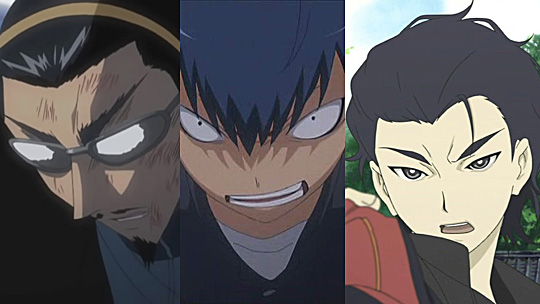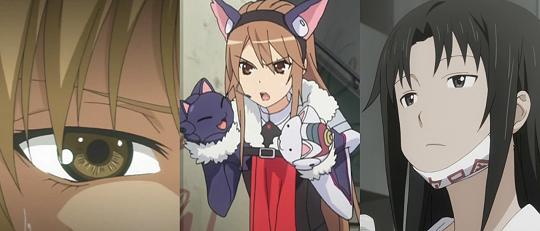Punks have been a staple of anime for as long as it's been around. The 2012 spring season alone features at least two shows - Accel World and Medaka Box - featuring them prominently in the opening episode and with the upcoming Kids on the Slope sporting a central character who fits the definition.
At the heart of the punk idea is a rebellious youth, whether part of a gang or standing alone, a delinquent or just misunderstood, there exists an endearing quality to them that crosses countries and societies. These are far from the 70's and 80's image of Sid Vicious and The Sex Pistols and closer to that of James Dean in Rebel Without a Cause.
That arms-length approach is how a great deal of the real Japan would rather deal the issue. Academics are split on exactly what drives a youth to the popularised kind of brash and anti-social lifestyle: some suggest low educational scores compounded by a less affluent upbringing, reinforcing an apathy from the lack of job prospects; others claim that stunted social skills could be to blame or even the very act of labelling someone a delinquent makes it so and encourages a group mentality - gangs and syndicates, not neighbourhoods and clubs - that is claimed to be at the heart Japanese society.
These latter points could be to blame for the majority of "misunderstood" delinquents, think Ryuuji from Toradora!, Hasegawa from Boku wa Tomodachi ga Sukunai or Akiharu from Ladies Versus Butlers. Isolated and alone they've been branded either through a misunderstanding or because of their looks and are treated with fear, regardless of the facts. It often takes an accident or another "maladjusted" individual to break that spell but it's disappointing that such a self-fulfilling prophecy could be perpetuated - how many others haven't had the chance to break out from their pigeon-hole and remain a pariah?

Gang culture is part of Japan whether that's the Yakuza or the Bosozoku, the speed tribes that patrol the highways and cities - look to Nurse Witch Komugi or the film Kamikaze Girls for the most common, clownish representation of them or Akira for the converse. The former sprung up after World War II and have been both venerated by the countless films on them, look no further than the Yakuza Papers series for that, and most recently vilified by books such as Jake Adelstein's Tokyo Vice. That requirement to belong starts at the bottom, with the new recruits, the chinpira, who are no better than organised thugs and must learn to respect and follow.
That ethos is instilled throughout a Japanese upbringing though, that elders are the authority holders, and it's no surprise that there would be some push back from such an overbearing approach. Practising punks then are well catered for with the likes of Seiji from Midori no Hibi, Harima from School Rumble, Makoto from Ghost Hound or, at a stretch, any of the main cast from Rainbow. All stalwart and honourable but opposed to society as a whole, like the misunderstoods, it takes a pure soul, an accident or old fashioned chutzpah to show society or the audience their true worth.
Gangs themselves meanwhile are often relegated to the sexually-charged fighting series such as Tenjou Tenge or Ikkitousen which often marginalises them as psychopaths or incompetent. The exception being the recent Durarara!! which prominently featured gangs, especially the so called "Colourless". This only deals with the male side of the equation though which naturally lends itself to testosterone and pugilism, female punks and delinquents aren't exactly as populous but still represent.
Again there are the misunderstood like Haruka from Minami-ke who fell into the role of the bancho or, the lesser known female variant, sukeban. Both Kyouko from Working!! and Ryouko from Ookami-san however are unabashed as to their status whereas others like Makoto Kino / Sailor Jupiter from Sailor Moon are left unexplored. Female gangs, although a real phenomenon in Japan are, barring pornography, unrepresented in anime and you have to turn to films such as Yo-Yo Girl Cop (based on a well-known weapon of choice of the girl gangs) or perhaps even the divisive Battle Royale to get a feeling for them.
Any number of different sources could be responsible for this diverse range of punks, deviants and misfits. The lone-warriors evoke the historical samurai spirit, a defender of good and bound to the bushido code. While the amorphous gangs seem more likely to be a response to the woolly juvenile laws in Japan combined with the intense pressure that schooling exerts on a child - for without an education how could a child hope to attain the high standing job and the respect of their peers?
Regardless of their proliferation though, little is said of reform or reintegration into society and if anime is anything to go by, simply beating them into unconsciousness is often enough to mend their ways. The overriding ideal however is that these people don't need to change, only to be understood or even encouraged - look no further than something like Gurren Lagann for this, would Kamina and subsequently Simon be treated as anything other than delinquents in today's society with their talk of revolution?
Ordinarily these reprobates would be seen as a symptom of a much larger ill, but as with many issues, delinquency is afforded media scrutiny but the real impact is far more restricted. The lament of youth is always repeated by adults from as far back as ancient Greece and likely even further. So the humble punk is here to stay, whether as fodder for fists or underdog outsiders, spare them a thought before beating them senseless or cowering from their wild eyes.

